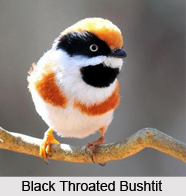 Black-Throated Bushtit is an Indian Bird that bears a scientific name Aegithalos concinnus recognised as the sub species of small passerine bird. Black-Throated Bushtit is marked with geographical variation, and very preliminary genetic studies suggest that this species may, in fact, represent an unresolved species swarm.
Black-Throated Bushtit is an Indian Bird that bears a scientific name Aegithalos concinnus recognised as the sub species of small passerine bird. Black-Throated Bushtit is marked with geographical variation, and very preliminary genetic studies suggest that this species may, in fact, represent an unresolved species swarm.
Races of Black-Throated Bushtit
The races of Black-Throated Bushtit divided into three groups, iredalei forming one group, annamensis another, and remaining four races forming "nominate group". The race annamensis is morphologically distinct, and its separation as a full species could well be justified on this basis alone.
Features of Black-Throated Bushtit
Black-Throated Bushtit also known as the Black-Throated Tit and it is a very small passerine bird in the family of Aegithalidae.
Structure of Black-Throated Bushtit
Black-Throated Bushtit is a small passerine, around 10.5 cm long and weighing 4-9 gram. There is considerable racial variation in the plumage, but all subspecies have a medium length tail (as opposed to the long tail of the related long-tailed tit), a black throat and a black `bandit mask` around the eye.
Race of Black-Throated Bushtit
The nominate race of Black-Throated Bushtit has a chestnut cap, breast band and flanks and dark grey back, wings and tail, and a white belly. The other subspecies have generally the same pattern (minus the chest band) but with grey caps or all grey bellies and flanks. Both sexes are alike.
Habitat of Black-Throated Bushtit
Black-Throated Bushtit ranges from the foothills of the Himalayan Mountain Range like Himachal Pradesh, Uttar Pradesh, Punjab, Jammu and Kashmir stretching across northern India through Nepal, Bhutan, northern Burma, Vietnam, and Taiwan. Disjunctive populations also occur in southern Vietnam and the island of Hainan. It lives in open broadleaf forest as well as pine forest, generally occurring in middle altitudes.
Behaviour of Black-Throated Bushtit
Black-Throated Bushtit is highly social and will travel in large flocks of up to 40 birds.
Nests of Black-Throated Bushtit
The nest of Black-Throated Bushtit is constructed out of moss and lichen and hangs from the branches of trees.
Feeding of Black-Throated Bushtit
Black-Throated Bushtit feeds on small insects and spiders, as well as small seeds, fruits and berries (particularly raspberries). Group numbers swell during the non-breeding season, but smaller groups exist year round. These groups will often join mixed-species feeding flocks.



















